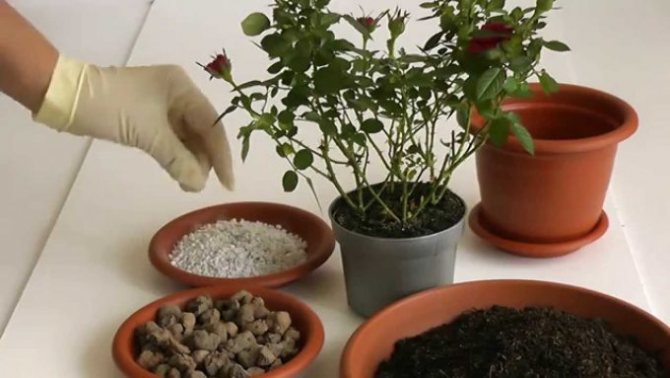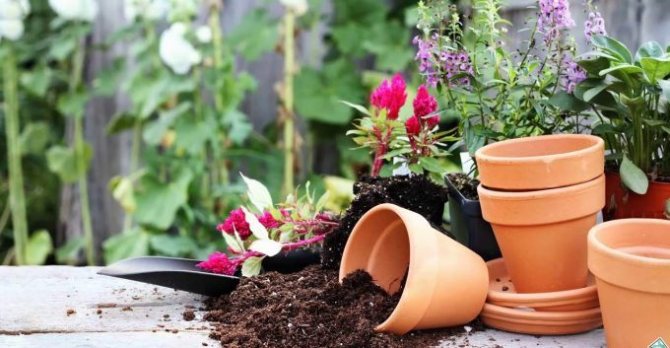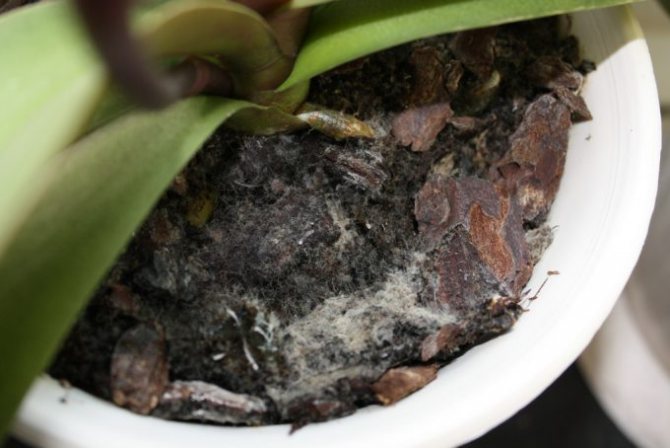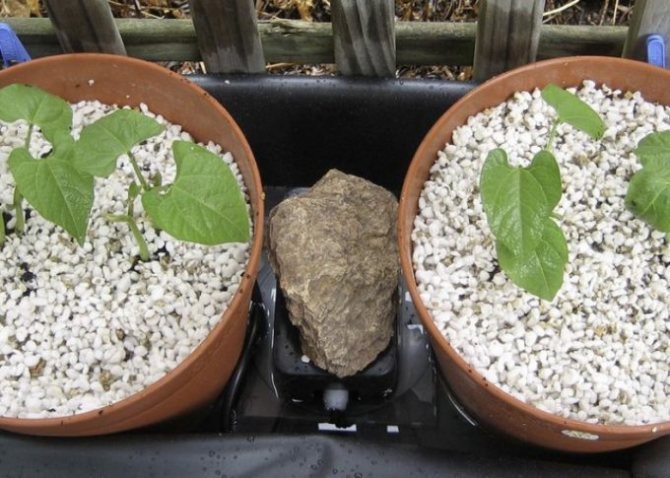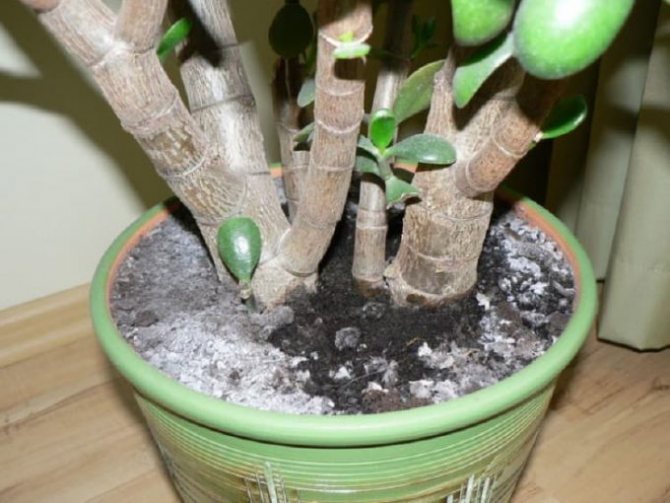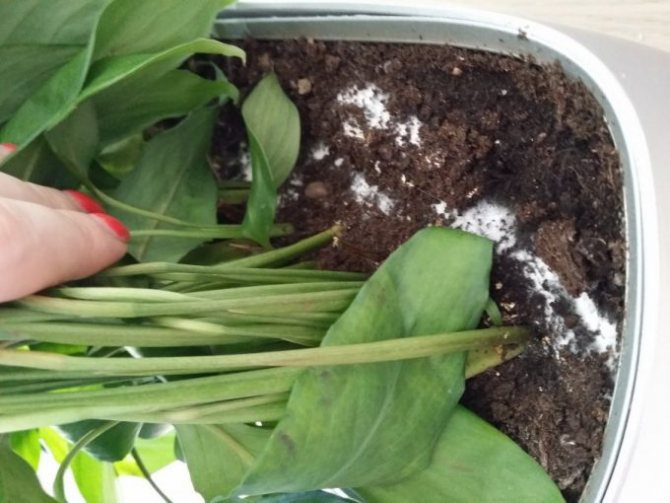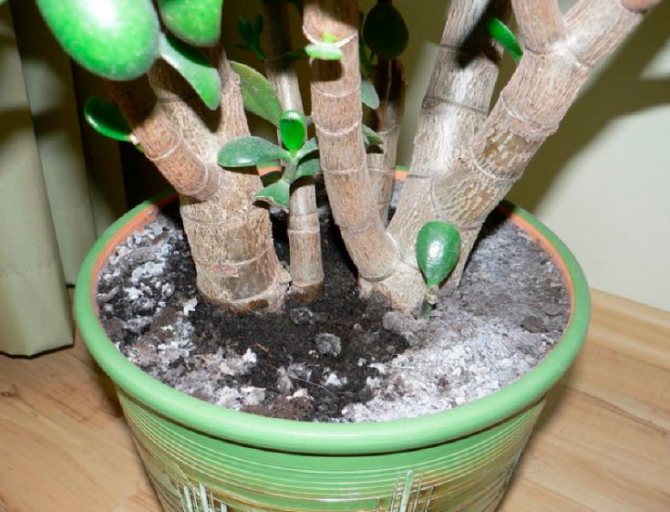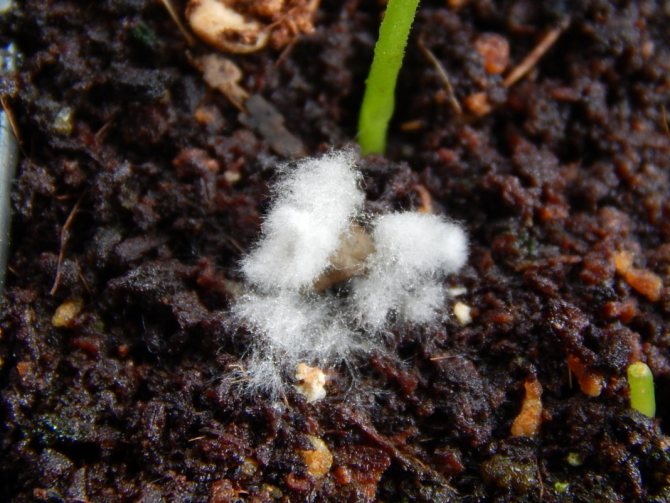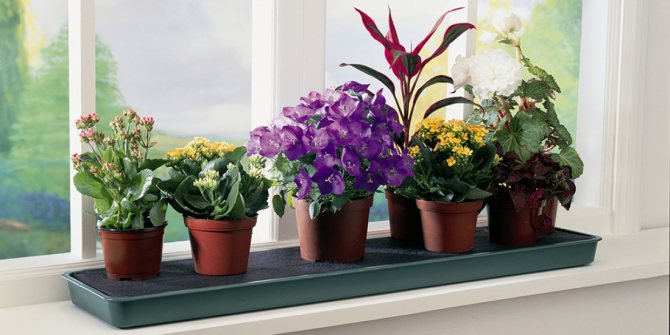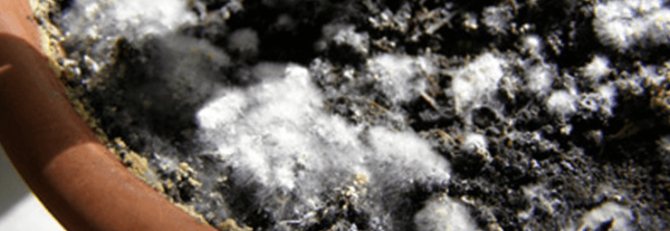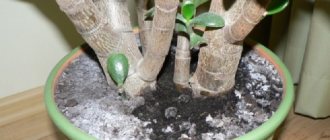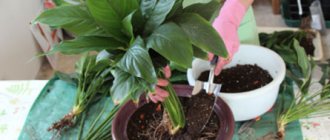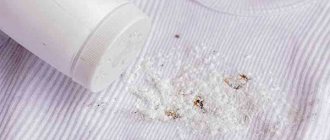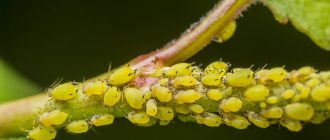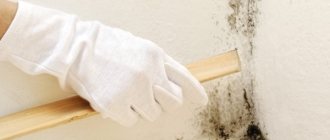
Most amateur flower growers periodically face such a problem as white mold on the ground in flower pots. Newbies are especially upset, but realizing the reasons: it seems like they bought a good soil mixture in a store, and bought large beautiful pots, and the plant was chosen for a feast for the eyes - some expensive orchid. Mold in a flower pot how to get rid of it? And so, after a while, the soil became covered with threads with a characteristic unpleasant odor. The impression is that the soil has "deteriorated".
A novice florist has questions: “What did I do wrong? How to preserve the plant, not let it die? " And most importantly: mold in a flower pot - how to get rid of it?
What is mold
It is also known from the school course in biology: mold is a fungus. Like every mushroom, it reproduces by spores. The smallest particles of mold are constantly present in the air of our apartments. As soon as the humidity rises, and here it is - mold. Spawns on the walls of damp rooms. Covers bread that is steamed in a plastic bag. And lined with a raid with a characteristic smell - earth in a flower pot.
There are several types of fungus.
Black mold
Despite the name, it is not only black. Can cover walls, ceilings, multiply on foods. It is difficult to get rid of it. In the old days they said that if black mold has settled in the house, it is easier to burn down the house than to remove it... People suffering from allergies are especially hard-pressed to be near these "dark spots".
White mold
More common and less dangerous. It appears on the ground, on plants, sometimes on food. Sometimes it can be confused with a plaque of mineral salts protruding from the soil. The main difference is that soft "fluffy" mold literally melts if you knead it with your fingers.
Blue fungi
A bluish blue color is distinctive for the colony of these fungi. It is especially dangerous for wood, contributing to its rapid decay.
Actinomycetes
Another type of fungus that is dangerous for trees and wood products. You can get rid of it only with the help of special poisonous substances.
Efflorescence
Most common. A layer of mold gleaming with tiny crystals. It can form not only on the surface, but also penetrate into the soil.
This is also interesting: How to deal with a wireworm in a potato?
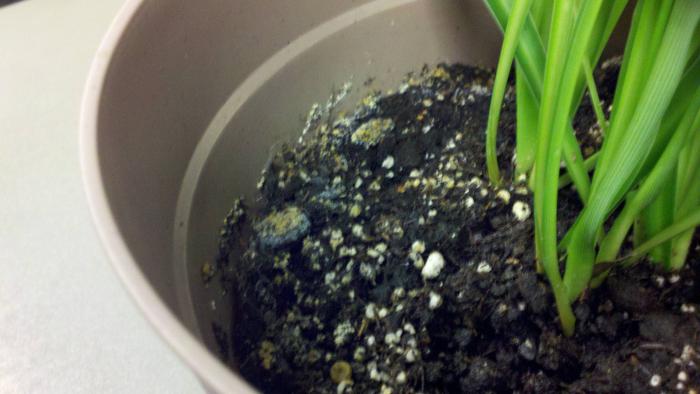

Where does flower mold come from?
Anyone who has anything to do with indoor plants has had to deal with a white or yellowish bloom on the walls of the pot. It is this plaque that is the initial stage of mold development.


The most vulnerable to fungal diseases are plants that are not very demanding for watering, which cannot immediately absorb a large amount of liquid. Among these plants, we single out cacti, succulents, violets and others.
There are not so many varieties of fungi that are dangerous to plants.
Types of mold:
- White mold is exactly the same white bloom that collects on the walls of the pot. Over time, it becomes more and more voluminous, and in the later stages of development it resembles a fluffy blanket. Often, white mold is confused with a mineral deposit, but the mold is softer and thinner to the touch.
- Blue mold - bluish fungal organisms prefer wood, so they are most dangerous for indoor trees, wooden flower pots and planters.
- Black mold is the most dangerous species that poses a threat not only to plants but also to humans. Black fungus is difficult to notice on the soil, but the mold that has accumulated on the walls of the pot is immediately evident. Black mold closely resembles earth and this often leads to confusion. But, unlike earth, mold is very difficult to wash off - even after treatment with a strong detergent, ingrained traces of the fungus will surely remain on the surface.
Under what conditions does mold form in a flower pot
In order for mold to appear in flower pots, prerequisites are needed. So why is this happening? The best conditions for the rapid growth of fungi are humidity and cool indoor air:
- this happens in a cold and rainy summer, especially if the window is constantly open in the room;
- if you live on the ground floor, above the basement, and dampness enters the apartment (in this case, mold will also appear on the walls, on the corners of the room);
- in autumn and spring, when there is no heating. It is not hot in the house, plants need less moisture, and they do not so actively absorb it from the ground;
In addition, there are other reasons:
- picking up the land for flowers yourself, you run the risk: the soil can be "infected" with fungi;
- you chose heavy clay soilwhere moisture stagnates;
- at the bottom of the pot no drainage layer;
- the holes for the excess water out of the pot are clogged.
One or two of these reasons are enough for mold spots to appear on the surface of the earth, and you smell rot.
Why is mold dangerous?
Since people are used to treating fungal diseases, it seems quite obvious that they are also dangerous for plants. And here it is worth highlighting a few key points.
- Deterioration of the soil. The quality of the substrate affected by mold is greatly reduced. It disrupts not only water, but also mineral metabolism, as well as acid-base balance, its composition changes, becomes unsuitable for cultivated plants.
- Plant death. Mold turns the topsoil into a crust that is impervious to air and retains water. The roots of plants do not tolerate excessive moisture and begin to rot, which leads to the death of the plant. Moreover, due to all these negative changes, it does not receive enough nutrients, which also harms and leads to death. The same fate can be expected also for the lower branches and leaves and young shoots of flowers.
- Room contamination. If you are dealing with black mold, then the danger is especially great. It can spread to windowsills, frames, walls and ceilings. And black mold is harmful to the human body, especially when it comes to children, old people and allergy sufferers.
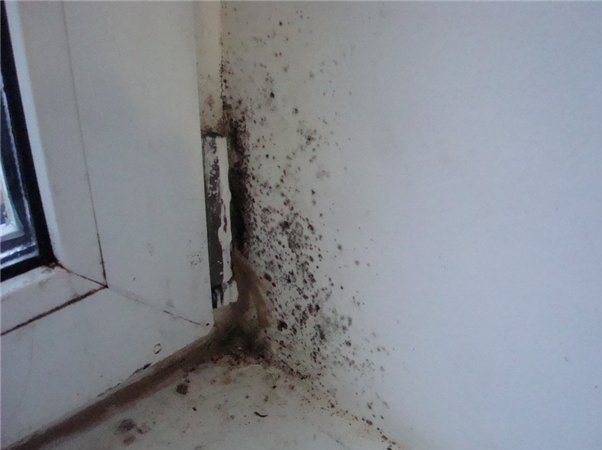

Black mold, following the plants, can infect both the window and the windowsill.
First aid measures
The first thing that growers want to do when they find mold in a pot is to immediately dig up the plant and transplant it into new soil. You may have to do so, but try less drastic measures first. After all, a transplant is always stress for a plant.
- In the beginning, it is worth giving up frequent watering. It is better to moisten the soil once abundantly than to do it a little every day.
- Move the pot to the brightest and driest place in the apartment and do not go to the flower with a watering can for several days. Let the soil dry out well.
- Raise the pot: check if the drain holes are clogged. Clean them if necessary.
- Carefully remove the top moldy soil. Loosen the surface. Moisture will stagnate less, penetrate the soil easier and deeper.
- Add fresh soil. In some articles, you will come across advice - to ignite the earth on fire. But many experienced flower growers reject this recommendation: after heating to high temperatures, the microflora necessary for the plant will be killed in the soil. Instead, growers advise covering the ground in a flower pot with light mulch for a few centimeters. Let's say you put scalded and then dried hay on it.
- In the future, the plants can be watered by adding potassium permanganate to the water - at the tip of a knife. The color of the water should only be slightly pink. An excessively strong solution of potassium permanganate can burn the roots of plants. This is an effective remedy. After treating the soil, the mold smell will disappear quickly. This method will also relieve the filaments of the fungus in the ground.
This is also interesting: Ways to get rid of mold and mildew in basements
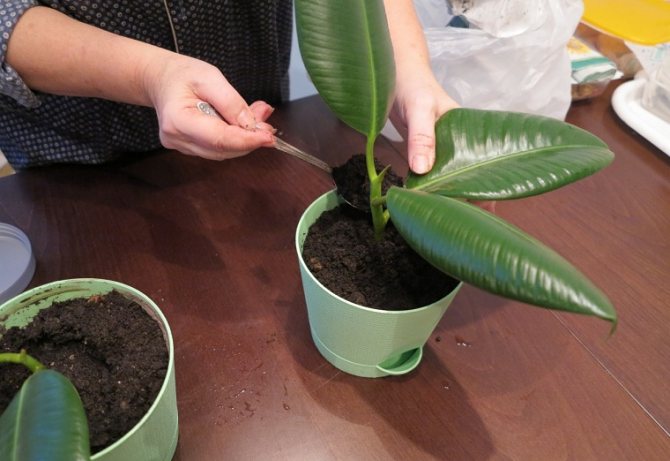

Soluble salts - efflorescence
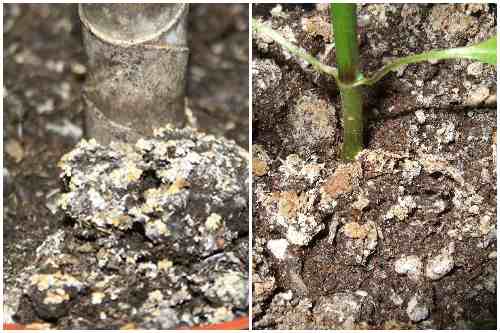

Any water used for irrigation contains soluble salts. Their concentration is different: hard or well water contains a large amount of salts. The smallest amount of elements contains rain, melt, the so-called "soft" water. Depending on the microelements present, the color of efflorescence will differ: calcium salts will give a white tint, and with an excess of iron, the ground on top will be yellow or brown.
This phenomenon often affects heavy soils with poor drainage, frequent surface watering. When the water does not completely wet the earthen lump, soluble salts do not go well to the roots and stay on the surface.
Too fertilized soil can also cause efflorescence. If the microelements do not have time to be absorbed by the flower, they begin to come to the surface.
How to deal with salt deposits
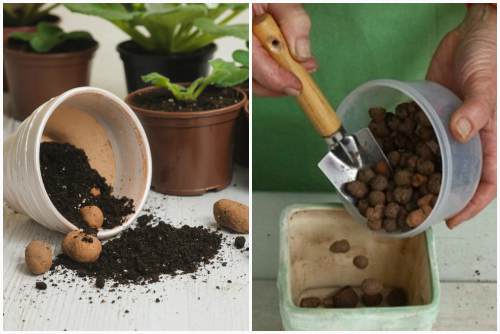

In order to get rid of plaque, the cause of its appearance is eliminated:
- Replace the topcoat carefully.
- If possible, use soft water: rainwater or tap water, well-separated.
- Reduce the frequency of watering by increasing the volume of liquid so that the earthen clod is completely saturated.
- Provide good drainage, clean clogged drainage holes.
- Loosen the top layer of the earth regularly.
How to tell mold from efflorescence
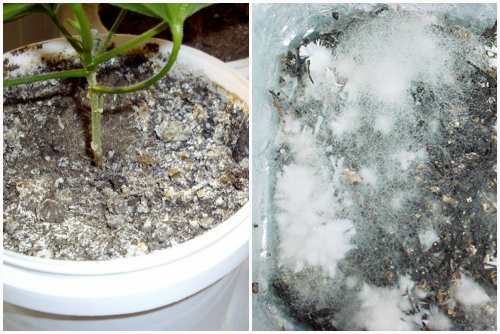

The fungus protrudes several millimeters above the soil surface, its structure is soft, delicate, easily rubbed between the fingers.
Efflorescences resemble a thin coating, difficult to separate from the ground, rough to the touch.
How to soften water for watering flowers
The easiest way is to collect rainwater. But this option is poorly suited for industrial areas, since the raindrops will collect dust, chemical elements in the air.
- Use well-settled water. For watering, take the top layer, excluding shaking.
- Filtered water. There are special filters for hard water that soften it by trapping calcium salts.
- Melt water. Take ordinary tap water out into the cold or place it in the freezer. Salt-free liquid freezes earlier; complete freezing should not be allowed. Then the non-frozen water is drained, and the ice is thawed. Water prepared in this way will be soft and biologically active - "alive".
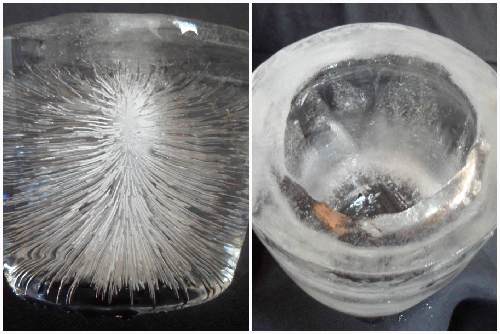

- It is good to use aquarium water for watering. But provided that no medicinal substances or other additives were added to it.
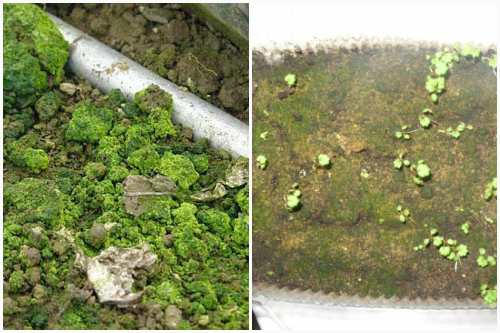

The moss in the pot looks like a green bloom. The reason for its appearance is high humidity. Most often it can be seen in near-water compositions, orchid pots. Moss itself is not dangerous, but it must be removed. Because it compacts the surface of the earth even more, exacerbating the already poor aeration.
If you still need a transplant of indoor plants
If the above measures did not help, it is possible that the plant will need a transplant.
Dig the flower out of the ground carefully. Treat the roots weak solution potassium permanganate.
The moldy soil should be thrown away and the pot disinfected.If it is ceramic, you can hold it in the oven, or pour boiling water over it. Please note that plastic pots are difficult to decontaminate, and there is a good chance that fungus spores cannot be completely removed from them.
Pour a few centimeters of drainage at the bottom of the pot - you can buy it at specialty stores such as Priroda. The drainage should be followed by soil, also purchased from the store (give preference to "light" soils, with a lot of peat).
Then plant the plant.
And remember that from now on you will water it much less often than before.
Folk ways of dealing with various raids
Folk remedies involve the use of safe methods:
- Transplanting a plant, or replacing the top layer of soil.
- Using a weak solution of potassium permanganate. This method is effective only against mold, since potassium permanganate has fungicidal (antifungal) properties.
All types of mold, efflorescence, moss, appear on dense, poorly drained soils. Improving the structure of the soil, loosening, and regulated watering will help prevent this trouble.
Treatment and prevention
As with any living creature, a plant trapped in soil infected with a fungus may require treatment.
- From chemical agents, foundation is suitable. You can buy it in shops that sell goods for the garden and vegetable garden. Instructions are attached to the preparation. In 1 liter of water, dissolve 2 g of foundationol, process the soil, stem and leaves of the plant.
- Activated carbon is used by mixing it with earth.
- Wood ash is used.
- You can water the plants 1-2 times with water to which lemon juice is added, or a sachet of citric acid.
- Folk remedies include the following: add pieces of chopped garlic to the ground, and change them from time to time.
To prevent the appearance of mold in the future, follow these simple rules:
- When purchasing new pots, go for ceramic, not plastic.
- The pot should not be too large for the plant.
- Keep flowers in dry rooms, avoid drafts.
- Pour with settled water, from time to time you can add a few crystals of potassium permanganate or 1-2 tablespoons of lemon juice to it.
- It is advisable to buy the soil in the store. Be sure to pour drainage at the bottom of the pot.
- Purchase houseplant care tools. Loosen the soil in the flower pot periodically, making sure that the drainage holes are not clogged.
- It is recommended to cover the ground surface with a layer of mulch.
remember, that mold can appear in a pot of any plant: be it a simple violet, or a rare orchid. The main thing is to notice the problem in time, prevent fungi from spreading, and penetrate deep into the soil. Therefore, if indoor floriculture is your hobby, it is better to buy the necessary preparations, the same foundation, in reserve. Forewarned is forearmed.
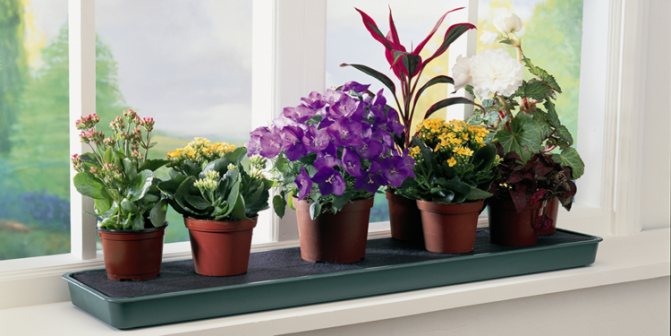

How to deal with mold
Rot often forms on the soil surface and indicates poor flower care. Sometimes the owner does not pay attention to the plaque that has appeared, does not realize that the seedling is infected with a fungal infection.
The reasons for the development of mold:
- the air temperature is below + 18˚С;
- high humidity;
- improper watering;
- poor quality substrate consisting of heavy or acidic soil.
Rot in a flowerpot forms at any time of the year and affects different flowers. At the end of September, before the start of the heating season, mold covers most of the soil in the flowerpot. moisture evaporates slowly and stagnates in the pan. To prevent the development of the fungus, the florist, after watering, loosens the ground in the flowerpot, establishing the correct exchange of air.
Experienced flower growers water the indoor seedling not with water, but with a solution containing juice squeezed from 1 lemon. Take 250 ml of liquid, add 10 g of citrus fruit juice and process the soil. As a result, fungal spores in the upper soil layer die.
Often, yellow rot develops in the flowerpot. To destroy it, the owner uses activated carbon. During a flower transplant, sphagnum and crushed enterosorbent tablets are added to the soil mixture. If mold appears in the flowerpot, and the indoor seedling is lagging behind in growth, withers and withers, it is necessary to use Fundazol. The flower grower introduces the drug into the soil, treats the leaves and stem with it.
Sometimes the substrate is covered with black rot. Soil contamination occurs as a result of exposure to high humidity. Mold of this color is dangerous not only for the plant, it also adversely affects human health, causing the appearance of allergies and disturbances in the functioning of the respiratory system.
Sometimes gray and green spots appear on the top layer of the soil, which are the result of chemical processes in the soil. Efflorescences destroy the inner part of the substrate, affecting the growth and development of the seedling.
A flower grower, sensing the smell of rot from a flowerpot, draws attention to watering a houseplant. If the soil is waterlogged, root rot may develop. An experienced florist closely monitors the condition of the top layer and removes plaque as soon as he detects a change in the color of the soil.
Waterlogging leads to the penetration of the pathogen into the middle layers of the substrate and the rapid death of the plant. Many growers transplant the flower into a new pot, completely replacing the potting mix.
The soil is purchased at a flower shop. When making a purchase, it is necessary to take into account the type of plant in order to determine in advance the permissible moisture content. The flower grower disinfects the soil by pouring boiling water over it, followed by calcining in the oven.
The pot is fired over an open fire. After processing, the substrate is poured into a pot, then the plant is planted.
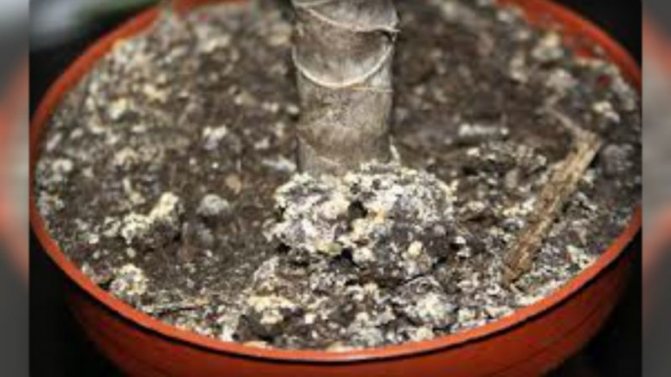

Rot often forms on the soil surface and indicates poor flower care. Illustration for this article is used under a standard license.
The soil in the seedling box is moldy
This is also interesting: Mold stains on a baby stroller: what to do?
Another problem that can be encountered in the spring is the appearance of mold in the seedling box.
Freshly planted seeds want to water more often, in addition, many people stretch plastic bags on boxes with seedlings, or cover boxes with glass to create a greenhouse effect.
As a result, young plants get sick. Moreover, such a tendency is noted. Tomatoes and peppers, which have already grown a little, do not take mold. It is the seedlings that suffer, and they are the hardest to help.... Tiny plants have not yet passed the pick, they are at a short distance from each other, their roots are thin as strings.
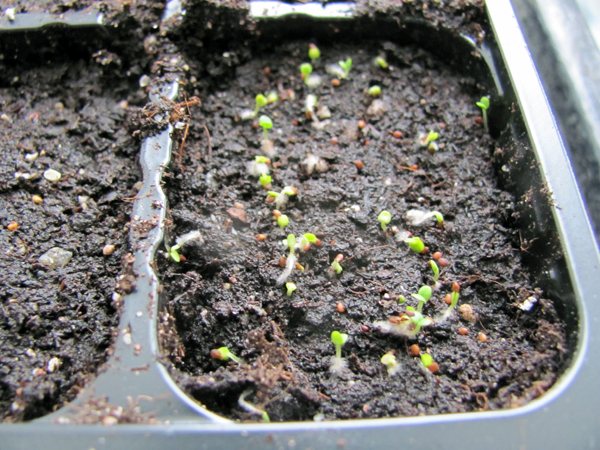

What can be done in this case
Amateur vegetable growers are advised to do this. First of all, you need dry the soil... Remove plastic or glass from the box, place the seedlings on a windowsill, illuminated by the sun. You just need to make sure that the earth does not dry out, otherwise the seedlings may die.
When the soil is dry a small layer of ash should be scattered on top... This must be done carefully, protecting the plants so that the ash does not stick to them. You can use a teaspoon, brush.
Now watering seedlings should be less often... And when you transplant it - in a larger box or in a permanent place in the garden, try not to use soil that has been affected by mold. To do this, shake each plant slightly so that the soil adhering to the roots crumbles.
Professionals warn: if you notice mold, you can't hesitate, the seedlings may die. The surface of the soil should be mulched regularly, every 2-3 weeks. It is best to use a mixture of charcoal and ash.
If you store land for seedlings in the fall, taking it from your garden or the nearest forest, such the soil should be pre-treated, watering abundantly with water with potassium permanganate, and drying.You can add river sand to the soil, as well as a mixture of humus with leafy soil.
- When watering seedlings, experts recommend using the water obtained as a result of melting snow. Or scoop it up from the aquarium.
- If the soil continues to be covered with white spots, repot the plants. If you use the same box, disinfect it first.
The problem with mold in pots needs serious attention. The question of how to get rid of this resistant fungus worries many. remember, that the appearance of mold does not mean that your favorite plant will die... The main thing is to immediately start fighting the insidious fungus.
How to deal with a fungus?
So, we found out that fungal microorganisms can harm not only plants, but also people. Now the next question is - how to deal with them? The first thing to do is to transplant the plant into a new pot and replace the soil. It is better to discard the old substrate, and rinse the pot thoroughly with boiling water.
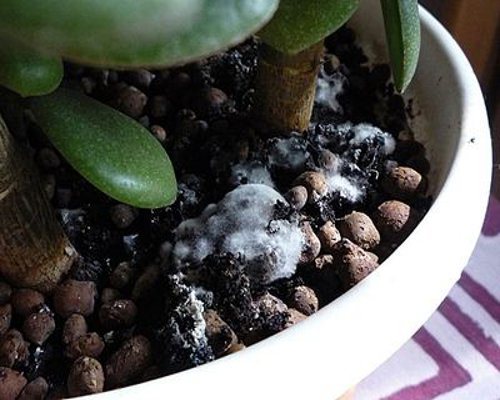

If you do not have enough new soil, only the top layer of the substrate can be replaced. In severe cases, you can use one of the methods below.
Chemicals
The best way to kill mold in a pot is to treat it with fungicides. All these drugs are divided by specialists into two groups: organic and inorganic. In principle, only the second group of drugs can be called “chemical”, since inorganic agents, unlike organic ones, kill fungal microorganisms using chemical compounds.
One of the most effective drugs is "Fundazol". It must be dissolved in water - 2 g per 1 liter, and then spray the leaves of the affected plants with the finished mixture. "Fundazol" is very toxic, therefore, when working with it, it is imperative to use gloves and a respirator.
Almost all anti-mold remedies contain benomyl, a substance that can destroy the fungus in the shortest possible time. As an alternative to Fundazol, you can use Ferazim - this drug is easier to obtain and no less effective.
If we talk about less toxic drugs, then first of all it is necessary to mention such drugs as "Oksikhom", "Skor" and "Topsin". They can be used both to kill fungal microorganisms in a pot and to treat infected plants. Each of these preparations must be diluted in water (the ratio is indicated in the instructions), and only after that the soil and leaves must be treated with a ready-made solution. Yes, chemicals are very effective, but if they are used incorrectly, you can harm not only the flower, but also yourself. Therefore, it is important to strictly follow all safety rules and adhere to the instructions indicated on the box.
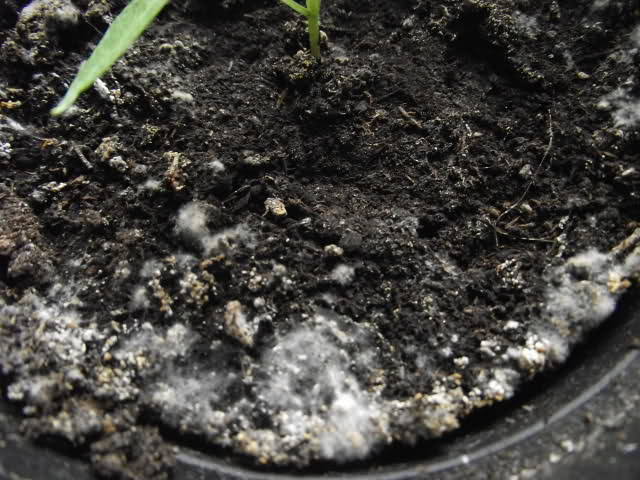

Now let's talk a little about organic preparations. They contain bacteria, the vital activity of which is aimed at fighting mold. Most of these drugs not only treat the affected plants, but also improve the chemical composition of the soil.
The greatest demand is for Fitosporin. This preparation contains soil bacteria that destroy the fungus and its spores. Fitosporin is marketed in the form of powder, paste and solution. Powder and paste must be dissolved in water in a 1: 2 ratio. As for the solution, it is already sold ready-to-use - you just need to water the soil and infected plants. A small amount of liquid soap can be added for greater effect.
Among other organic products, we will single out "Trichodermin", "Baktofit" and "Fitolavin". Most of the drugs are presented in the form of powder and concentrate, but there are also tablets (for example, "Glyocladin"). The main advantage of organic products is that they are non-toxic and do not pose any threat to human health.
Folk remedies
Gardeners who do not trust chemistry and believe that it is harmful to plants use folk methods to combat mold. Some of them are presented below:
- Citric acid - stir a few drops of citric acid in water, and spray the affected plants with the resulting solution. In the future, it is important to repeat this procedure once a month. Important: experts do not recommend treating the soil with high acidity with citric acid.
- Garlic is an effective “grandma's” method, which involves dropping chopped cloves of garlic around the perimeter of the pot. Garlic may start to rot. It is important to keep track of this and replace it with new teeth, otherwise another serious source of mold could form.
- Coal - the advantage of this product is that it is always at hand, and it is not difficult to get it. You can buy activated charcoal at any local pharmacy. Grind the tablets and mix them with the substrate. Many gardeners use charcoal. You can buy it at a hardware store or simply scoop it out of the oven. It can also be mixed with the substrate, but it is better to just cover the soil with a small layer of it. For greater effect, experts advise combining coal with river sand.
Traditional methods
Means from this category will work effectively if a white bloom has appeared on a cactus or other plants recently (early stages of the disease) or as a prophylaxis.
- Dissolve 25 g of soda ash and 5 g of liquid soap in 5 liters of hot water. Let the prepared liquid cool. Spray the topsoil and plant with the chilled solution 2-3 times. The interval between sprays is a week.
- 1 tbsp. l. baking soda and half a teaspoon. dissolve liquid soap in 4 liters of water. Spray the plant and soil 2-3 times. The interval is 6-7 days.
- Dissolve 2.5 g of potassium permanganate in 10 liters of water. Use 2-3 times. The interval is 5 days.
- Pour 100 g of fresh horsetail with 1 liter of water. Withstand a day. Put on fire and boil for 1-2 hours. Strain, cool, dilute with water (1: 5) and process the bushes. Store the solution for no more than a week in a dark, cool place. Spraying as a preventive measure can be carried out regularly in spring and summer. During the disease (in the early stages), the plants are treated 3-4 times. Frequency - once every 5 days.
- Dissolve 5 g of copper sulfate in 250 ml of hot water. Dissolve 50 g of soap separately in 5 liters of warm water. Pour the solution with vitriol into the soapy liquid in a thin stream, stirring constantly. Spray the plant with the finished product 2-3 times. The interval is 6-7 days.
- 1-2 tbsp. l. Pour dry mustard into 10 liters of hot water. Water or spray the plants with the cooled solution.
- Stir 1 kg of ash in 10 liters of heated water. Let the solution sit (3-7 days), stir it regularly. Drain water into a clean container, add a small amount of liquid soap and pour into a spray bottle. Treat the plants 3 times every day or every other day. The liquid remaining in a separate container, which was drained from the finished product, can be additionally diluted with water and subsequently used for irrigation.
- Fill the rotten manure (preferably cow) with water (1: 3). Let it brew (3 days). Dilute with water in half and spray the bushes.
- Pour 25 g of chopped garlic with 1 liter of water. A day later, when the product is infused, strain and spray the plants.
What to do if a white bloom appears on the leaves of the plant?
Powdery mildew (ash, linen) - a rapidly spreading fungal disease.
The first "symptom" is a white bloom on the leaves, which at first glance may seem like ordinary dust. When the leaves are covered with it, the plant loses nutrients, and the process of photosynthesis stops.
At first, white bloom appears only on the lower leaves of violets and other plants, but over time the disease progresses, moving to the rest of the plant.The leaves turn yellow, wither, and the new leaves have an unhealthy appearance, grow twisted.
If you do not take up the treatment of the plant in time, it will soon die.
What are the reasons for the disease?
Fungal spores are always found in the soil, but with proper plant care, they are not “activated”. The fungus begins to manifest its evil essence if:
It's damp, cold outside
For example, it rains every day. In this case, white bloom on the leaves of ficus and other plants often appears when they are grown on the street or balcony.
Irrigation regime is not observed
For example, white bloom on the leaves of begonia and other flowers appears if the plant is watered too often, when the top layer of the earth has not yet dried.
Helpful hints:
- In autumn, when the microclimate at home changes and favorably affects the development of fungus on flowers, loosen the soil in flowerpots more often.
- Add crushed sphagnum and activated charcoal tablets to the fresh soil.
- Pour the ground with a foundation solution (2g per 1 liter of water).
- The development and reproduction of dormant spores of the fungus will help prevent lemon juice (1 teaspoon in a glass of water).
- Water your flowers with a manganese solution 1 to 2 times every month.
Follow our advice and your flowers will delight you, your loved ones and friends with their beauty and health.
Types of mold: white, efflorescence
On the surface of the soil in a pot of flowers, there are most often two types of fungi:
- white - very similar to fluff and easy to grind in your hands;
- efflorescence - such a crystalline coating can be white, gray or green.
Efflorescences are more dangerous, since this plaque develops not only on the surface of the soil, but can also affect the inner part of the soil.
How can harm the plant
In addition to the fact that white bloom spoils the aesthetic appearance of the soil and affects it with fungal spores, it also affects the plant itself.
White deposits on the soil surface can cause to the following consequences:
- the flower will stop developing;
- oxygen access will decrease, and the roots will no longer receive useful substances;
- the acidity of the soil will be disturbed and the mineral composition of the soil will change;
- pets can get sick with fungal diseases and perish;
- most often, the plant begins to shed its leaves due to a lack of nutrients in the soil.
As you can see, seemingly harmless white bloom can lead to death. Therefore, you should not start the situation and immediately start fighting mold on the soil surface.
Causes of the appearance and spread of the fungus
There may be several reasons why a fungus forms on the surface of the soil:
- Using the wrong regime of watering the plant, which leads to stagnation of liquid and an increase in soil moisture.
- Low temperature and high humidity of the room in which the flower is located.
- Application for cold water irrigation.
- Poorly functioning drainage system. If the holes do not match the size of the pot, then they are clogged. Which leads to stagnation of water in the soil. After 2-4 days, the first traces of mold may appear.
- Poor quality soil.
The rapid rate of mold spreading is facilitated by excess moisture and infrequent ventilation... The most common time for infection to appear is in the fall and spring. During these periods of time, cold air accumulates in the room, which leads to a slow evaporation of moisture from the soil surface. As a result, there is stagnation of fluid and the spread of fungal spores.
The cause of the appearance of the fungus can be increased dampness in the house. This may be due to a poor communication system or the presence of a basement.

